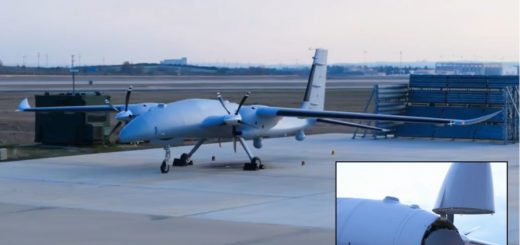U.S. General Atomics enhances European unmanned combat aircraft development with German partner company

{loadposition bannertop}
{loadposition sidebarpub}
According to information published by General Atomics on July 17, 2025, the company has launched a major new initiative to deliver a Collaborative Combat Aircraft (CCA) tailored for European forces. This advanced uncrewed system will be based on the U.S. Air Force’s YFQ-42A prototype and manufactured through a transatlantic partnership between General Atomics Aeronautical Systems, Inc. (GA-ASI) in the United States and its German affiliate, General Atomics Aerotec Systems GmbH (GA-ATS), in Oberpfaffenhofen, Germany. The program aims to deliver a combat-ready, customizable drone platform equipped with European mission systems and built in Europe to meet NATO’s evolving airpower needs rapidly.Follow Army Recognition on Google News at this link
A production-representative YFQ-42A test aircraft is prepared in Poway California as the US Air Force begins ground testing under the Collaborative Combat Aircraft program to assess performance and readiness for upcoming flight trials. (Picture source: U.S. DoD)
The General Atomics YFQ-42A unmanned combat aircraft was launched into development in early 2024 as a direct evolution of the XQ-67A Off-Board Sensing Station, which itself first flew in February 2024 under the U.S. Air Force’s low-cost autonomous drone initiative. While the XQ-67A was focused primarily on sensing and electronic support missions, the YFQ-42A has been designed from the outset as a next-generation uncrewed combat aircraft capable of operating independently or alongside crewed fighters in high-threat environments. General Atomics used the proven airframe, propulsion integration, and autonomous architecture of the XQ-67A as a foundation, accelerating the YFQ-42A development timeline to under 18 months. This was made possible through digital engineering, advanced manufacturing, and modular open system design.
As of mid-2025, the YFQ-42A has completed its structural assembly and is now in advanced ground testing at GA-ASI’s facility in San Diego, California. The aircraft is undergoing full-system integration checks, propulsion tests, and software validation with its autonomous mission systems. First flight is planned for late summer 2025, marking a significant milestone in the fast-tracked production of a fully capable uncrewed combat aircraft. The platform is designed to be attritable yet operationally relevant, with stealth-optimized aerodynamics, secure communications, and mission flexibility across air-to-air, strike, reconnaissance, and electronic warfare roles.
The European variant of this platform will be assembled and supported by GA-ATS in Germany, enabling European customization and sovereignty over mission systems, payloads, and sustainment. GA-ATS brings four decades of experience in aircraft manufacturing and maintenance, including NH90 helicopter MRO for the Bundeswehr and production of the Dornier 228 multi-role aircraft. Its integration into the YFQ-42A program provides a critical European industrial base to deliver and maintain these aircraft within NATO territory. European mission systems such as radar, sensors, electronic warfare suites, and guided munitions will be integrated to align with national requirements and enhance interoperability with existing NATO airpower.
General Atomics CEO Linden Blue emphasized that the combined efforts of GA-ASI and GA-ATS would ensure the rapid delivery of a combat-proven, affordable, and scalable platform for European air forces. The company has already delivered over 1,200 unmanned aircraft across global markets and logged nearly 9 million flight hours. Its track record includes the MQ-1 Predator, MQ-9 Reaper, MQ-20 Avenger, and more recently, the XQ-67A. By drawing on this legacy, the YFQ-42A program offers a high-confidence path to fielding next-generation unmanned combat capability.
The European Collaborative Combat Aircraft initiative will not only provide timely operational capability but also reinforce defense-industrial cooperation between the United States and key European allies. The project supports ongoing NATO priorities for unmanned-manned teaming, distributed air operations, and the development of affordable mass to offset peer threats. With a mature airframe, flexible payload design, and a growing base of transatlantic industry participation, the YFQ-42A-derived platform is positioned to become a core component of NATO’s future aerial combat force.
In conclusion, the launch of this European Collaborative Combat Aircraft program by General Atomics reflects a broader global shift in airpower strategy. Countries including the United States, United Kingdom, France, Germany, Australia, Japan, and India have all initiated major efforts to develop unmanned combat aircraft designed to operate alongside manned fighters. These programs aim to increase survivability, multiply force effectiveness, and reduce cost per combat sortie. The YFQ-42A initiative, now entering flight testing, stands as one of the most mature and strategically significant examples of this rapidly emerging class of autonomous combat systems.

{loadposition bannertop}
{loadposition sidebarpub}
According to information published by General Atomics on July 17, 2025, the company has launched a major new initiative to deliver a Collaborative Combat Aircraft (CCA) tailored for European forces. This advanced uncrewed system will be based on the U.S. Air Force’s YFQ-42A prototype and manufactured through a transatlantic partnership between General Atomics Aeronautical Systems, Inc. (GA-ASI) in the United States and its German affiliate, General Atomics Aerotec Systems GmbH (GA-ATS), in Oberpfaffenhofen, Germany. The program aims to deliver a combat-ready, customizable drone platform equipped with European mission systems and built in Europe to meet NATO’s evolving airpower needs rapidly.
Follow Army Recognition on Google News at this link
A production-representative YFQ-42A test aircraft is prepared in Poway California as the US Air Force begins ground testing under the Collaborative Combat Aircraft program to assess performance and readiness for upcoming flight trials. (Picture source: U.S. DoD)
The General Atomics YFQ-42A unmanned combat aircraft was launched into development in early 2024 as a direct evolution of the XQ-67A Off-Board Sensing Station, which itself first flew in February 2024 under the U.S. Air Force’s low-cost autonomous drone initiative. While the XQ-67A was focused primarily on sensing and electronic support missions, the YFQ-42A has been designed from the outset as a next-generation uncrewed combat aircraft capable of operating independently or alongside crewed fighters in high-threat environments. General Atomics used the proven airframe, propulsion integration, and autonomous architecture of the XQ-67A as a foundation, accelerating the YFQ-42A development timeline to under 18 months. This was made possible through digital engineering, advanced manufacturing, and modular open system design.
As of mid-2025, the YFQ-42A has completed its structural assembly and is now in advanced ground testing at GA-ASI’s facility in San Diego, California. The aircraft is undergoing full-system integration checks, propulsion tests, and software validation with its autonomous mission systems. First flight is planned for late summer 2025, marking a significant milestone in the fast-tracked production of a fully capable uncrewed combat aircraft. The platform is designed to be attritable yet operationally relevant, with stealth-optimized aerodynamics, secure communications, and mission flexibility across air-to-air, strike, reconnaissance, and electronic warfare roles.
The European variant of this platform will be assembled and supported by GA-ATS in Germany, enabling European customization and sovereignty over mission systems, payloads, and sustainment. GA-ATS brings four decades of experience in aircraft manufacturing and maintenance, including NH90 helicopter MRO for the Bundeswehr and production of the Dornier 228 multi-role aircraft. Its integration into the YFQ-42A program provides a critical European industrial base to deliver and maintain these aircraft within NATO territory. European mission systems such as radar, sensors, electronic warfare suites, and guided munitions will be integrated to align with national requirements and enhance interoperability with existing NATO airpower.
General Atomics CEO Linden Blue emphasized that the combined efforts of GA-ASI and GA-ATS would ensure the rapid delivery of a combat-proven, affordable, and scalable platform for European air forces. The company has already delivered over 1,200 unmanned aircraft across global markets and logged nearly 9 million flight hours. Its track record includes the MQ-1 Predator, MQ-9 Reaper, MQ-20 Avenger, and more recently, the XQ-67A. By drawing on this legacy, the YFQ-42A program offers a high-confidence path to fielding next-generation unmanned combat capability.
The European Collaborative Combat Aircraft initiative will not only provide timely operational capability but also reinforce defense-industrial cooperation between the United States and key European allies. The project supports ongoing NATO priorities for unmanned-manned teaming, distributed air operations, and the development of affordable mass to offset peer threats. With a mature airframe, flexible payload design, and a growing base of transatlantic industry participation, the YFQ-42A-derived platform is positioned to become a core component of NATO’s future aerial combat force.
In conclusion, the launch of this European Collaborative Combat Aircraft program by General Atomics reflects a broader global shift in airpower strategy. Countries including the United States, United Kingdom, France, Germany, Australia, Japan, and India have all initiated major efforts to develop unmanned combat aircraft designed to operate alongside manned fighters. These programs aim to increase survivability, multiply force effectiveness, and reduce cost per combat sortie. The YFQ-42A initiative, now entering flight testing, stands as one of the most mature and strategically significant examples of this rapidly emerging class of autonomous combat systems.






